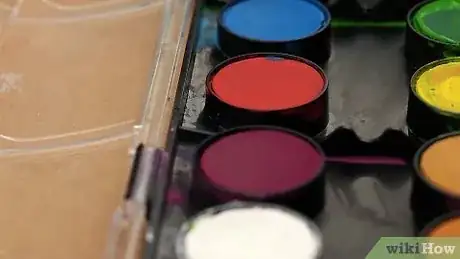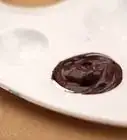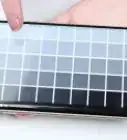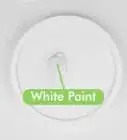This article was co-authored by Jeanine Hattas Wilson. Jeanine Hattas Wilson is a Professional Painter and the President of Hattas Public Murals, Inc. With nearly 20 years of experience, Jeanine specializes in creating, overseeing, designing, and painting murals. Jeanine holds a BA in Advertising from Marquette University and a Studio Painting Minor from The Milwaukee Institute of Art & Design. She has studied at The Atelier Artien in Paris, France, Los Angeles Academy of Figurative Art, and under renowned artists such as Robert Liberace, Michael Siegel, and William Cochran. To date, Hattas Public Murals has painted nearly 5,000 commissioned works of art in homes and commercial and public spaces.
There are 8 references cited in this article, which can be found at the bottom of the page.
wikiHow marks an article as reader-approved once it receives enough positive feedback. In this case, 100% of readers who voted found the article helpful, earning it our reader-approved status.
This article has been viewed 494,932 times.
No color palette is complete without pink. While you can buy premade pink paint, it’s just as easy to mix your own. Plus, you’ll be able to get just the shade you want, whatever you are working on. Start with some of your favorite reds, then add white or dilute them, and you’ll be able to make a variety of beautiful pinks.
Steps
Mixing Pinks in Oil or Acrylic Paint
-
1Place some white and red paint on your palette. Add red to the white. Start by adding just a bit of red to the white, and mix well. Keep adding a bit of red at a time until you reach the pink you want to use for your work.[1]
- Most standard reds can be used to make a pink. Each red will produce a different shade of pink, so you can experiment until you find one that you especially like.[2]
- For the best results when mixing colors to make pink, choose an opaque white (such as Titanium White). Transparent whites (like Zinc White) may only lighten the red without creating a true pink.[3]
- Don’t try to create pink by adding white to red, since this will take more time and use up lots of paint.
-
2Add a complementary color to tone down your pink. Shades of colors are technically created by adding black to a hue. However, many painters find that using a complementary color instead of black creates better-looking colors. You can try adding a direct complementary (a green), but using a neighboring color like blue can also create nice results.[4]
- Whichever color you choose to tone down your pink, start by adding just a little at a time to the pink, and mixing well until you get the hue you like.
Creating Pinks with Watercolors
-
1Select a base color. There are a number of readily available watercolor hues that can be used to create beautiful pinks. You may like to use these colors more or less as-is, just thinned with just a bit of water. Choose a base color such as:[5]
- Permanent Rose
- Quinacridone Rose
- Ruby Red
-
2Dilute your base color to lighten it. Watercolors work by allowing the white of the paper to reflect light through the transparent layers of paint applied to them. To create a lighter pink, all you need to do is dilute your base color with enough water so that the layer becomes very transparent.
- Experiment by diluting your paint with various amounts of water on your tray before applying it to your paper. This will give you a feel for the kinds of pink you can make.
- You can also thoroughly wet your paper first and then apply a small amount of your red to create a pink wash.
-
3Use an alternate color to shade the pink. The tube colors will work great for areas of pink local color when diluted. To add shading, however, use a wash of a color like cobalt blue over a layer of pink.[6]
- Using an alternate color to create shading, rather than black, will result in richer, more vibrant colors.
-
4Use a warm color to brighten the pink. Applying an underwash of a warm color before applying a layer of pink will make the hue appear warmer and brighter. A yellow underwash can be especially effective.[7]
-
5Mix the pink with red to deepen the color. If your base color isn’t as rich as you would like it to be, select a deeper red. Mix it with some of your pink/rose red on your palette or tray, then thin to your desired saturation.[8]
Community Q&A
-
QuestionHow can I make a greyish pink?
 Tove AskhamCommunity AnswerWhite with a little red and a little ocher will make a beautiful, pale grey-pink.
Tove AskhamCommunity AnswerWhite with a little red and a little ocher will make a beautiful, pale grey-pink. -
QuestionHow do I make a golden color?
 Community AnswerYou could mix orange paint, yellow paint, and a shimmering white paint. This should make relatively golden paint.
Community AnswerYou could mix orange paint, yellow paint, and a shimmering white paint. This should make relatively golden paint. -
QuestionHow can I make dark pink from poster colors?
 Community AnswerMix red and white poster colors, and you'll get pink. You can try adding a touch of blue or green to make it darker.
Community AnswerMix red and white poster colors, and you'll get pink. You can try adding a touch of blue or green to make it darker.
References
- ↑ http://startstudioarts.si.edu/2013/11/tips-and-techniques-getting-started-with-oil-painting.html
- ↑ Jeanine Hattas Wilson. Professional Painter. Expert Interview.
- ↑ http://willkempartschool.com/how-to-choose-the-right-white-for-your-acrylic-painting/
- ↑ http://willkempartschool.com/how-to-mix-the-perfect-pink-paint-with-acrylics/
- ↑ https://www.dorisjoa.com/paint-pink/
- ↑ https://www.dorisjoa.com/paint-pink/
- ↑ https://www.dorisjoa.com/paint-pink/
- ↑ https://www.dorisjoa.com/paint-pink/
- ↑ Jeanine Hattas Wilson. Professional Painter. Expert Interview. 5 May 2021.
About This Article
To mix oil or acrylic paint to make the color pink, place red and white paint on your palette. If you want a natural pink, start with an earthy red, choose a bluish red for very bright pinks, or pick a cadmium red for a pink with hints of orange. Gradually add the red paint to the white, stirring with a stick, spoon, or palette knife, until you get the shade of pink you want. If you need to tone down your pink, add a little green, blue, or black paint to the mixture. If you want to learn how to mix watercolor paints, keep reading the article!

















































